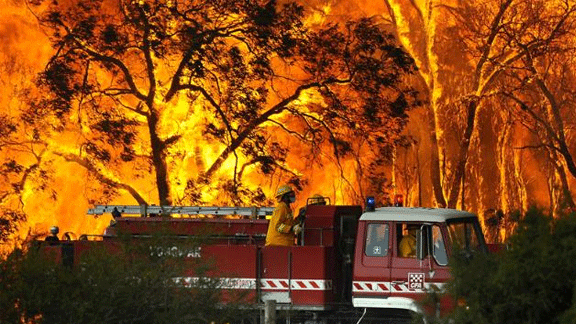Hot air from politicians as globe warms

The Intergovernmental Panel on Climate Change (IPCC) has published its Fifth Assessment Report (AR5) on climate change.
Written by more than 240 experts from 70 countries and citing more than 12,000 scientific references, it is the most comprehensive analysis of the state of our knowledge about climate change – and the starkest confirmation yet about the extent of global warming.
Despite the scientific consensus and dire warnings of the need for immediate action, politicians continue to fiddle while the planet burns.
“Nobody on this planet is going to be untouched by the impacts of climate change”, said Rajendra Pachauri, chairperson of the IPCC. As global temperatures increase due to continued greenhouse gas emissions, extreme weather events are becoming commonplace.
A hotter planet will result in island nations being submerged by rising sea levels; decreased global food production; larger floods; increased numbers of environmental refugees; increased rates of extinction of animals and marine life; and the worst is yet to come.AR5 specifically describes Australia as headed for enormous changes over the next 80 years. Across the country we will experience hotter and more frequent heat waves, more bushfires and an increase in heat-related deaths and hospitalisations.
If you thought last summer was bad, the report warns that by 2100 parts of Western Australia, Northern Territory, South Australia and Queensland could experience up to 192 days per year above 40 degrees.
Longer and harsher droughts are expected, with rainfall to decline by up to 40 percent in south-east Australia. The rest of the country will experience an increase in extreme rainfall and flooding.
It gets worse. The report cites a projected increase in diseases carried by water and food: up to 335,000 new cases of bacterial gastroenteritis each year by 2050 and outbreaks of malaria and dengue fever in a hotter Australia.
Increased heat stress and disease will disproportionately affect remote Indigenous communities. Rising sea levels threaten to displace many Torres Strait Islanders and the inhabitants of many islands in the South Pacific such as Kiribati and Tuvalu.AR5 paints a frightful picture of the future of our planet, yet the response of governments and the rich makes you think they’re living on Mars. Abbott dismissed the report, stating, “Australia is a land of droughts and flooding rains. Always has been, always will be.” He claimed that he will “take strong and effective action to deal with climate change … You’ve got to have smart policies, not dumb policies.”
Yes, smart policies. Like expanding coal seam gas fracking in Queensland – a technique which has resulted in such severe contamination of water resources in one part of the United States that residents can set their tap water on fire. Great way to save on your heating bill!
Or how about that ingenious policy of NSW Premier Barry O’Farrell to shut down 30 fire stations and sack 300 firefighters after recent bushfires?
With more people needing to visit hospital suffering from heat stroke, what better time to start cutting back on health care and charging people $6 per GP visit? Best of all, Abbott will stop the Great Barrier Reef being destroyed by warmer temperatures by getting the coal companies in there to destroy it first. Clever!
Back to reality. The steps needed even to mitigate the effects of climate change aren’t being taken, let alone any serious action to prevent climate change. The future laid out in AR5 is where we’re headed, but it’s not inevitable and it’s not too late.
What is needed is not a simple policy change, but an urgent radical change in the way our world works. For all the rhetoric about the efficiency of capitalism, this system of profit above all else is the biggest barrier to saving the planet.
The technology already exists for a world based on 100 percent renewable energy. Research by the Melbourne Energy Institute has shown that a 200km by 200km square of solar panels – .05 percent of total land space – would produce enough energy to power the whole of Australia. Include the use of wind and hydroelectric power, and the potential is enormous.
These are the sorts of “smart policies” that should be implemented, yet it is the mining companies and coal plant owners who have everything to lose from it. Let’s start by taxing Gina Rinehart’s $20 billion and BHP’s recently announced $8 billion profit, and fund renewables that way. If the system is geared towards upholding the profits of these corporations to the detriment of the planet, then the system needs to go.